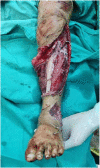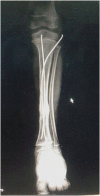Lower limb preservation in pediatric trauma: a case study of Gustilo grade IIIC fracture in a 7-year-old
- PMID: 38283407
- PMCID: PMC10810729
- DOI: 10.1093/jscr/rjae016
Lower limb preservation in pediatric trauma: a case study of Gustilo grade IIIC fracture in a 7-year-old
Abstract
This case report describes the intricate aspects of managing pediatric lower limb trauma. A 7-year-old patient had a severe compound fracture and significant soft tissue damage in the left lower limb, classified as Gustilo Grade IIIC. This necessitated the use of scoring systems such as the Mangled Extremity Severity Score and limb salvage index to assess the likelihood of limb preservation. Despite these high amputation risk indicators, a multidisciplinary approach has led to limb salvage surgery with internal fixation. Detailed postoperative monitoring revealed progressive recovery culminating in restored sensation, bone healing, and functional recovery. The discussion emphasizes the difficulties in deciding between limb salvage and amputation, stressing the importance of tailored care and cautious scoring system interpretation in pediatric cases. This conclusion advocates the prioritization of limb salvage in children owing to their unique healing capabilities while highlighting the need for further research to refine treatment protocols for pediatric lower limb trauma.
Keywords: Gustilo grade IIIC; case report; crush injury; internal fixation; limb salvage.
Published by Oxford University Press and JSCR Publishing Ltd. © The Author(s) 2024.
Conflict of interest statement
None declared.
Figures





Similar articles
-
Management of Grade 3C Compound Injury of Lower Limb with Floating Knee - Salvage versus Amputation (Case Series).J Orthop Case Rep. 2021 Feb;11(2):119-127. doi: 10.13107/jocr.2021.v11.i02.2052. J Orthop Case Rep. 2021. PMID: 34141685 Free PMC article.
-
Lower limb paediatric trauma with bone and soft tissue loss: Ortho-plastic management and outcome in a major trauma centre.Injury. 2020 Jul;51(7):1576-1583. doi: 10.1016/j.injury.2020.03.059. Epub 2020 May 7. Injury. 2020. PMID: 32444168
-
Third degree open fractures and traumatic sub-/total amputations of the upper extremity: Outcome and relevance of the Mangled Extremity Severity Score.Orthop Traumatol Surg Res. 2016 Oct;102(6):785-90. doi: 10.1016/j.otsr.2016.04.004. Epub 2016 May 18. Orthop Traumatol Surg Res. 2016. PMID: 27209033
-
Limb Salvage Versus Amputation: A Review of Variables Influencing the Assessment and Decision-Making in Complex Limb Fracture Management.Cureus. 2024 Nov 23;16(11):e74322. doi: 10.7759/cureus.74322. eCollection 2024 Nov. Cureus. 2024. PMID: 39720385 Free PMC article. Review.
-
Clinical effectiveness of the Ganga Hospital Open Injury Severity Score for limb salvage versus amputation in patients with complex limb injuries : a systematic review and meta-analysis.Bone Joint J. 2023 Jan;105-B(1):21-28. doi: 10.1302/0301-620X.105B1.BJJ-2022-0934.R1. Bone Joint J. 2023. PMID: 36587255
References
-
- Fairhurst PG, Wyss TR, Weiss S, Becker D, Schmidli J, Makaloski V. Popliteal vessel trauma: surgical approaches and the vessel-first strategy. Knee 2018;25:849–55. - PubMed
Publication types
LinkOut - more resources
Full Text Sources

